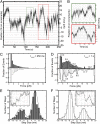Force measurements on cargoes in living cells reveal collective dynamics of microtubule motors
- PMID: 23091040
- PMCID: PMC3494964
- DOI: 10.1073/pnas.1215462109
Force measurements on cargoes in living cells reveal collective dynamics of microtubule motors
Abstract
Many cellular cargoes move bidirectionally along microtubules, driven by teams of plus- and minus-end-directed motor proteins. To probe the forces exerted on cargoes during intracellular transport, we examined latex beads phagocytosed into living mammalian macrophages. These latex bead compartments (LBCs) are encased in membrane and transported along the cytoskeleton by a complement of endogenous kinesin-1, kinesin-2, and dynein motors. The size and refractive index of LBCs makes them well-suited for manipulation with an optical trap. We developed methods that provide in situ calibration of the optical trap in the complex cellular environment, taking into account any variations among cargoes and local viscoelastic properties of the cytoplasm. We found that centrally and peripherally directed forces exerted on LBCs are of similar magnitude, with maximum forces of ~20 pN. During force events greater than 10 pN, we often observe 8-nm steps in both directions, indicating that the stepping of multiple motors is correlated. These observations suggest bidirectional transport of LBCs is driven by opposing teams of stably bound motors that operate near force balance.
Conflict of interest statement
The authors declare no conflict of interest.
Figures




References
Publication types
MeSH terms
Substances
Grants and funding
LinkOut - more resources
Full Text Sources

